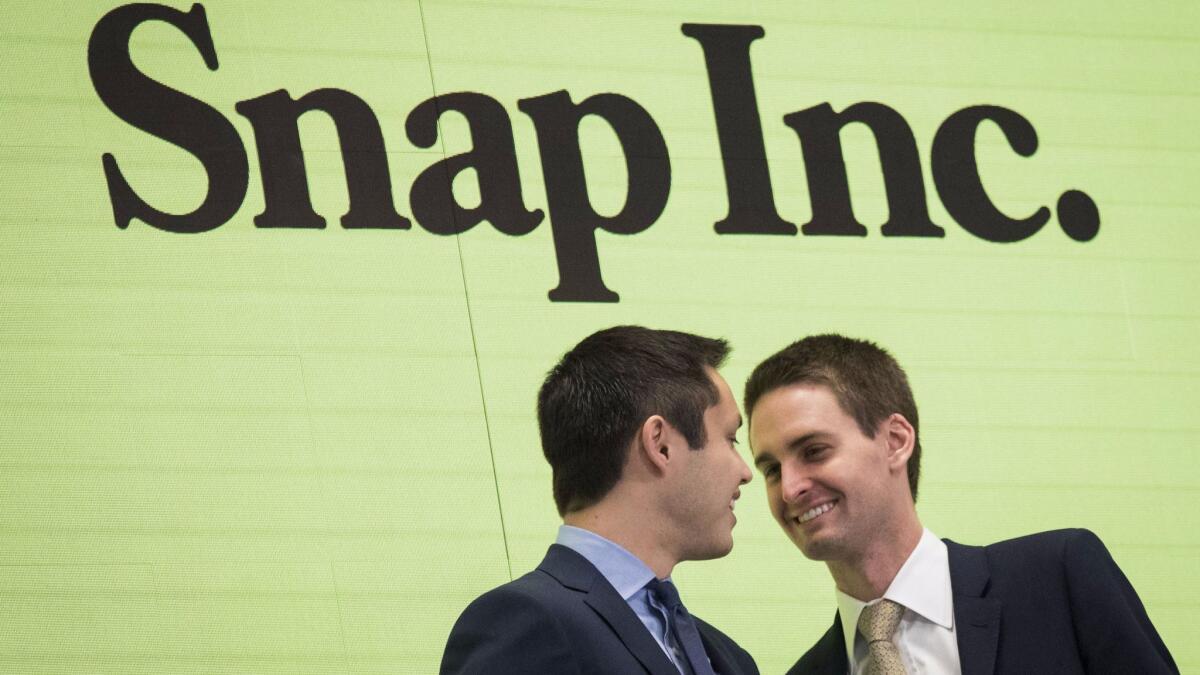Snapchat firm makes history in stock market debut

On Thursday morning, Snap Inc.’s 26-year-old Chief Executive Evan Spiegel and 28-year-old Chief Technology Officer Bobby Murphy swapped their beachside V-neck T-shirts for dark suits and gold and blue ties.
Standing before a sea of stock traders, the pair rang the opening bell at the New York Stock Exchange, marking the biggest initial public offering ever for a Los Angeles company, a milestone that places the Venice firm among the heavyweights of the technology world.
“How do we feel?” an exhausted, tieless Spiegel told the Los Angeles Times hours after the company made its Wall Street debut. “We were just thinking about how do we answer that question. It’s exciting.”
After pricing shares at $17 apiece to raise $3.4 billion, Snap saw its stock leap 44% to $24 when it began trading under the ticker symbol SNAP around 8:15 a.m. PST. Shares hovered around $25 before closing at $24.48, valuing the company at more than $34 billion. Demand for shares has been 10 times the supply despite questions about whether the popular photo and video messaging app will be able to fend off competitors like Facebook and continue to grow.
Thursday caps a momentous rise for the nearly 6-year-old company that was dismissed early on as a sexting tool born out of a Stanford University fraternity. It since has grown into a trend-setting chatting and entertainment service, famous for its disappearing messages and whimsical photo- and video-editing tools, used to swap faces or add bunny ears.
The company now has around 2,000 employees and a sprawling beachside presence. It has quickly helped establish Los Angeles as a vibrant tech hub and, to the distress of some locals, transformed the culture and identity of Venice.
The stock debut makes Spiegel, who grew up in Pacific Palisades, the youngest chief executive of a company listed on Nasdaq or the NYSE, according to FactSet. It also adds enormous wealth to Spiegel and Murphy’s personal coffers: each made $272 million from the IPO, and more than $1 billion in paper gains as shares soared after the first day of trading.
The IPO — the most lucrative in the U.S. since Alibaba raised $22 billion in 2014 — is also expected to mint hundreds of new millionaires, as employees begin cashing out stock grants earned as part of their compensation.
Facebook and Visa are the only California companies that brought in more cash than Snap through an IPO, according to FactSet data.
Financial analysts believe that the enthusiasm for Snap has been heightened by both the dearth of major stock debuts in recent years, as well as what is seen as the last chance for investors to jump on board the social media bandwagon.
“There has been a lot of pent-up demand from investors to have a piece of the new pie,” said Pai-Ling Yin, an associate professor of entrepreneurship at USC. “Snap’s timing is great for that, but you have to keep that in mind when considering how to interpret the first-day valuation.”
Analysts cautioned not to read too much into Thursday’s “pop” in pricing, which is not unusual for technology firms.
“During an IPO there’s a sense of euphoria, and people like to think they’re part of the latest and greatest thing, but current pricing does not reflect the risks and challenges the company will have to deal with later on,” said Clement Thibault, a senior analyst at Investing.com. “It’ll take a little while longer for the market to get a good judgement on Snap’s value.”
Still, that didn’t stop the company from celebrating.
Outside Snap’s main offices in Venice on Thursday morning, a steady trickle of about two dozen employees arrived early to work, some carrying balloons, others a bottle of wine or champagne.
When Spiegel and Murphy rang the opening bell in New York, cheers and applause erupted from inside the building.
Later in the day, when demonstrators gathered outside Snap’s offices in protest of the company’s effect on the neighborhood, about 250 Snap employees took to the Venice Whaler, a restaurant and bar about a mile south of Snap’s main offices on Market Street. A bartender said they had begun arriving by mid-morning.
Wearing T-shirts decorated with Snap’s signature ghost logo, Spectacles and name badges with bitmojis, they filled the upper level of the bar, looking out onto the boardwalk as CNBC played on TV.
Some snapped photos as they downed beers, shots and margaritas, periodically erupting in cheers.
“I think we’re all feeling pretty good,” said a Snap employee who declined to give her name.
The infusion of cash will allow Snap to expand, solidify its reputation and pay its investors, who funded the company’s rise. But the IPO milestone also means the company will be under additional financial scrutiny. Snap became the first company to sell IPO shares that lack voting power — a move that frustrated investors and has drawn the attention of regulatory advisors.
The company must also prove that it can make money and keep attracting new users.
Snap generated $404.5 million in revenue in 2016, mostly from ad sales, but operated at a $514.6-million loss. In regulatory filings, the company revealed its once feverish user growth has slowed, meaning its financial performance “will increasingly depend on our ability to elevate user engagement or increase our monetization of users.”
While it’s not unusual for an unprofitable company to go public, it remains to be seen whether Snap will take after Facebook, which last year made more than $10 billion in profit and now has more than 1.8 billion monthly active users, or Twitter, which continues to operate at a loss and has struggled with getting new people to use its platform.
“When Twitter user growth stalled, it led to a stalling of revenue growth,” said Ryan Jacob, whose firm Jacob Asset Management holds stocks in both Facebook and Twitter. “I don’t think anyone questions Snapchat’s advertising effectiveness. The question is, ‘Does the slowing continue or do they reaccelerate growth?’ That’s what everyone is going to focus on.”
The company has no shortage of hurdles. Its youthful demographic is seen as both a blessing (coveted by advertisers) and a curse (finicky and quick to move on). Facebook continues to nip at its heels, with the Facebook-owned Instagram and WhatsApp playing copycat to Snapchat’s features.
And now that it’s subject to the Security and Exchange Commission’s quarterly reporting requirements, the company will have to answer to Wall Street, which is notoriously unforgiving toward companies that fail to meet growth and earnings expectations.
“Every technology company gets some kind of grace period when it enters the market,” Thibault of Investing.com said. “But as soon as Snap’s first earnings report comes out, it will be compared to other companies.’”
That day is at least weeks away. For now, employees, executives, and investors are hitting Venice’s bars.
Lien reported from San Francisco, Dave from New York City, and Agrawal from Los Angeles. Times staff writers Samantha Masunaga and David Pierson contributed to this report.
Twitter: @peard33, @traceylien, @agrawalnina
ALSO
The guy who came up with the idea for Snapchat got $158 million and vanished from public life
Bobby Murphy cleaned up after frat parties; now he stands to clean up in Snapchat IPO
You might own Snap’s non-voting stock soon, like it or not
UPDATES:
4:35 p.m.: This article was updated with additional context and analysis.
12:35 p.m.: This article was updated with more recent market information, commentary from analysts and a quote from Chief Executive Evan Spiegel.
This article was originally published at 9:10 a.m.









